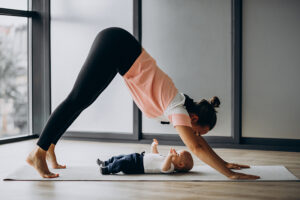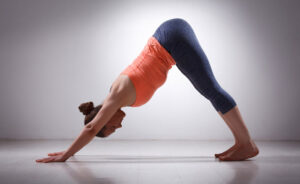Standing Tall with Yoga: Your Posture Pal!
Ever feel a bit hunched over after a long day hunched over your desk, or have that familiar ache in your back after a crowded bus ride? We’ve all been there! But what if I told you there’s a way to ditch the slouch and stand tall with confidence, just like how good posture is important in yoga poses like the lotus position?
Enter yoga, your new best friend for a straighter, healthier you. This ancient practice, deeply rooted in Indian culture for centuries, goes far beyond just touching your toes. It’s a full-body experience that combines gentle stretches, mindful breathing, and even meditation to leave you feeling amazing from the inside out.
The secret weapon of yoga for posture? Body awareness. Yoga helps you understand how your body moves and holds itself, allowing you to identify areas that might be contributing to your slouch. Think of it like detective work for your posture!
But how does it actually work? Picture yoga poses (called “asanas”) as targeted exercises for your muscles. They help them become stronger and more flexible, like giving them a gentle workout. This not only improves your overall flexibility but also helps fix any imbalances that might be causing your posture to go wonky.
Plus, yoga teaches you how to breathe properly, which strengthens your core muscles and supports your spine – just like a strong foundation supports a tall building.
The benefits of yoga extend far beyond just standing taller. Regular practice can make you more flexible, improve your balance, and even leave you feeling calmer and more relaxed. Whether you’re a gym enthusiast or just starting out, yoga offers a gentle and effective way to take charge of your health and well-being.
So, are you ready to say goodbye to bad posture and embrace a straighter, healthier you? Stay tuned, because in the next sections, we’ll be exploring specific yoga poses and techniques that can help you achieve just that. We’ll also delve into different yoga styles and help you find the perfect practice to fit your needs and preferences. Let’s embark on this journey together!
Understanding posture and its importance:
Posture is more than just standing up straight – it’s about the position and alignment of the entire body. Proper posture reduces strain, allows optimal organ functioning, and projects confidence. Conversely, poor posture can lead to various health issues over time.
Good posture involves having the ears, shoulders, and hips vertically aligned in a balanced, stable position. The spine maintains its three natural curves – neck and lower back curved in, mid back curved out. Proper alignment enables the core and back muscles to support the spine rather than strain.
When posture is off, the results manifest both physically and mentally. Slouching overstimulates the nerve roots along the spine, causing back and neck pain. Rounded shoulders and forward head lead to headaches and pinched nerves. Poor lung expansion from slumping restricts oxygen flow, resulting in fatigue and reduced concentration.
Beyond pain and discomfort, bad posture communicates lack of engagement and low self-esteem. Drooping shoulders and head down reflect disinterest or dejection. Standing tall with chest lifted projects confidence and energy.
Working to improve posture promotes overall wellness. Small adjustments throughout the day help retrain muscles. Set reminders to roll shoulders back and lift chest while sitting or standing. Maintain the natural spinal curves by strengthening the core and stretching tight chest and hips.
Proper sleep postures also matter – side and back positions align the spine neutrally. While posture perfection is unrealistic, being mindful goes a long way. Periodic corrections will help good posture become a healthy habit.
Rather than a cosmetic concern, good posture is about reducing chronic pain, breathing easier, decreasing injury risk, and boosting state of mind. A balanced, supported frame allows us to live and move with less strain and discomfort. Make postural awareness a lifelong practice.
Yoga to the Rescue: Poses for Better Posture
Yoga offers a natural and effective way to improve your posture. The combination of stretches, strengthening exercises, and mindful breathing helps lengthen tight muscles, strengthen weak ones, and improve your body awareness, all of which contribute to better posture.
Here are some yoga poses that target specific areas and can help improve your overall posture:
1. Mountain Pose (Tadasana): (This pose is suitable for beginners)
- Stand tall with your feet hip-width apart, big toes touching or slightly separated.
- Distribute your weight evenly on both feet.
- Engage your core by gently drawing your navel in towards your spine.
- Lengthen your spine upwards, as if trying to reach the ceiling with your crown.
- Relax your shoulders down and back, away from your ears.
- Hold for 5-10 breaths, focusing on your breath and maintaining good alignment.

2. Downward-Facing Dog (Adho Mukha Svanasana): (This pose requires some upper body strength)
- Start on your hands and knees, with your hands shoulder-width apart and knees hip-width apart.
- Push your hips back and up, straightening your legs as much as possible without locking your knees.
- Keep your heels flat on the ground or stretch them towards the ground.
- Engage your core and lengthen your spine.
- Keep your gaze focused between your legs or slightly forward.
- Hold for 5-10 breaths, focusing on your breath and maintaining a flat back.

3. Child’s Pose (Balasana): (This pose is suitable for all levels)
- Kneel on the floor with your toes together and knees hip-width apart.
- Sit back on your heels, resting your torso between your thighs.
- Rest your forehead on the floor or a folded blanket.
- Stretch your arms out in front of you, palms facing down.
- Breathe deeply and relax your entire body.
- Hold for as long as comfortable.

4. Cat-cow Pose (Marjariasana and Bitilasana): (This pose is suitable for all levels)
- Start on your hands and knees, with your hands shoulder-width apart and knees hip-width apart.
- As you inhale, arch your back, dropping your belly towards the floor and looking up.
- As you exhale, round your back, tucking your chin to your chest and looking towards your navel.
- Repeat the movement several times, flowing with your breath.

5. Warrior I Pose (Virabhadrasana I): (This pose requires some balance)
- Stand with your feet hip-width apart.
- Step one foot back, bending the back knee at a 90-degree angle.
- Keep your front knee aligned over your ankle.
- Raise your arms straight overhead, palms facing each other.
- Engage your core and keep your gaze forward.
- Hold for 5-10 breaths on each side, focusing on your breath and maintaining good alignment.

Safety Tips:
- Listen to your body and avoid pushing yourself into pain.
- If you have any injuries or health concerns, consult with a doctor or yoga instructor before practicing these poses.
- It is always best to learn yoga poses with a qualified instructor who can provide you with proper guidance and address your individual needs.
By incorporating these yoga poses into your regular routine, you can start experiencing the numerous benefits of good posture, including improved flexibility, strength, and confidence. Remember, consistency is key, so aim to practice these poses regularly for optimal results.
Beyond the Yoga Mat: Keeping Your Posture in Tip-Top Shape
Yoga is a powerful tool for strengthening your body and improving your posture, but it’s not the only trick up your sleeve! Here are some additional tips and lifestyle changes that can help you maintain good posture throughout the day, whether you’re conquering a warrior pose or conquering your to-do list.
1. Ergonomics: Your Everyday Superhero:
- Desk Defender: Choose a chair that’s got your back (literally!). Look for one with good support and adjust it so your feet are flat on the floor, knees bent at a 90-degree angle, and elbows doing the same while you type. A footrest can be your secret weapon here!
- Phone Posture Patrol: Slouching over your phone is a recipe for neck pain. Hold it up high, near eye level, to avoid that hunch.
- Carry On, Comfortably: Distribute the weight of your belongings evenly on both sides of your body. Backpacks with padded straps are champions; ditch the one-handed bag struggle.
2. Core Strength: The Secret Weapon:
Strong core muscles are like an internal support system for your spine, helping you stand tall and move with ease. Exercises like planks, bridges, and supermans (no cape required!) are simple yet effective ways to build core strength.
3. Stretch It Out:
Tight muscles can pull you out of alignment, making good posture a challenge. Regular stretching helps increase flexibility and range of motion, allowing you to move freely and maintain good posture. Focus on stretches for your chest, shoulders, hamstrings, and lower back.
4. Mindful Movement:
Throughout your day, pay attention to your posture, especially when sitting, standing, and walking. If you catch yourself slouching, gently remind yourself to straighten up. Taking short breaks to move around and stretch can also help prevent slouching.
5. Shoe Power:
Wearing shoes with good arch support can help distribute your weight evenly and improve your overall body alignment.
Bonus Tip: Invest in a foam roller or tennis ball and use it to release tension in your muscles, especially your back and shoulders. This can help improve your posture and flexibility.
For the Curious:
Want to learn more about ergonomics and stretching exercises? Check out the websites of reputable organizations like the American Physical Therapy Association (APTA) or the Mayo Clinic.
Remember, consistency is key! The more you focus on maintaining good posture, the more natural it will become. So, ditch the slouch and embrace a confident, well-aligned you!
Your Journey to a Pain-Free, Confident You
Remember that slouchy feeling we talked about earlier? By incorporating yoga and posture awareness into your daily life, you can say goodbye to that and hello to a healthier, happier you. Here’s a quick recap:
- Yoga offers a gentle yet effective way to improve your posture. By stretching tight muscles and strengthening weak ones, you can improve your body alignment and flexibility, leading to better posture naturally.
- Maintaining good posture has numerous benefits beyond just looking good. It can help reduce pain, improve your breathing, and even boost your confidence.
- Remember, consistency is key! The more you practice yoga and focus on good posture, the more natural it will become.
Taking your journey a step further:
If you’re looking for personalized guidance and support on your posture improvement journey, consider exploring resources like FlexifyMe. Their team of certified trainers and experienced physiotherapists can create a personalized plan to address your specific needs and help you achieve your goals.The choice is yours! Whether you choose to embark on your yoga and posture journey alone or seek additional support, remember that every step you take towards better posture is a step towards a healthier, pain-free, and more confident you.


